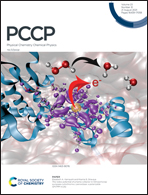Generation, contraction, and polarisation of Gaussian basis sets for atomic and molecular calculations using the generator coordinate method with polynomial discretisation: atoms from Na through Cl†
Abstract
The polynomial Generator Coordinate Hartree–Fock Gaussian basis sets, pGCHF, for the atoms Na, Mg, Al, Si, P, S, and Cl were generated using the generator coordinate method based on polynomial integral expansion to discretise the Griffin–Wheeler–Hartree–Fock equations. The pGCHF basis sets were contracted with the CONTRACT program based on the Davidson contraction model through which a set of 9s8p functions for the atoms Na through Cl were obtained. Polarisation exponents generated using the POLARIZATION program were added to the contracted pGCHF Gaussian basis sets. Molecular calculations at the DFT level of theory showed that the pGCHF basis sets can be used to calculate the atomisation energy with accuracy comparable to the well-established pcseg-3, def2-QZVP, and Sapporo-QZP basis sets; also, the complete basis set (CBS) limit estimate was obtained with the pcseg-3/pcseg-4 basis sets.



 Please wait while we load your content...
Please wait while we load your content...